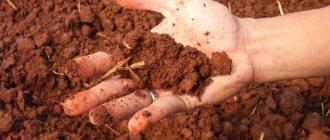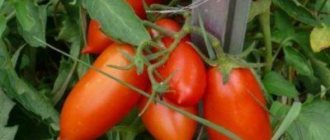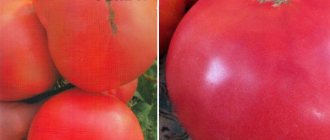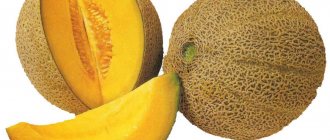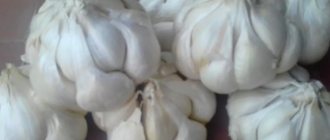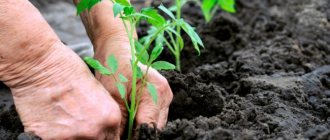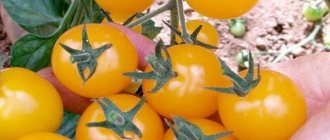Tomato varieties that are resistant to late blight for greenhouses Quite a few have already been released. In our article we tried to offer the best of them and gave them characteristics; a detailed description is also provided late blight, methods of combating it, factors provoking the disease are considered,
Tomato plague, the most terrible disease of tomatoes - these are the names summer residents gave to late blight. This disease can lead to the death of nightshade crops. late blight throughout the entire period of tomato cultivation . For decades, vegetable growers have been inventing various methods to destroy the causative agent of tomato disease.
This has led to the emergence of various methods in the fight against late blight. There are conventional means, such as the use of drugs, and exotic ones, which include the use of copper wire for the roots of tomatoes, as well as sprinkling the plants with fresh milk.
Tomato varieties resistant to late blight for greenhouses
Today there are no types of tomatoes that are completely protected from late blight and are never affected by this disease. They are also affected by late blight, but tolerate it much more easily, since they are highly resistant to fungal infections.
Tomato varieties for greenhouses resistant to late blight:
- Lark is a determinate variety, the height of which does not exceed 80-90 cm. Ripening time is up to 75-85 days. The fruits are large, weighing 110-130 g. The pulp is sweet, juicy, without sourness. The variety has good shelf life during storage and transportation.
- Cardinal is one of the most popular varieties for greenhouses. Tall bushes, up to 170-200 cm, require mandatory shaping and gartering. The fruits are large, dark red in color, and ripen alternately throughout the season.
- Oak is an early ripening variety grown in greenhouses. Ripening time does not exceed 85-95 days. Bushes up to 65-75 cm high, fruit weight does not exceed 80 g.
- Gypsies are low-growing plants with a height of 70-80 cm, in some cases reaching 100 cm. Ripening time is 105-110 days. The advantage of this variety is excellent seed germination and high yield. The fruits are large, up to 160 g, of an unusual red-brown color.
- Carlson - compact and neat plants in a greenhouse can reach 180-200 cm. Ripening time does not exceed 85-90 days. Carlson pleases summer residents with tasty and large fruits weighing 180-220 g. The yield of the variety reaches 8-10 kg per bush.
- Parsley gardener - refers to semi-determinate early ripening varieties. The height of the bushes is 170-200 cm. The first harvest can be harvested 95-105 days after the appearance of seedlings. The fruits weigh 330-370 g. With proper agricultural technology, you can get up to 8 kg of harvest from each bush.
Tomato varieties resistant to late blight also include Resonance. Bushes with a height of 110-135 cm delight with tasty and sweet fruits within 90-95 days from the moment of planting the seedlings. Resonance is often grown for sale, as its large fruits weighing 250-330 g attract attention with their symmetrical round shape, rich scarlet color, elasticity and excellent keeping quality.
Late blight - what is it?
Late blight of tomatoes - photo The disease described in the article is caused by the fungi Phytophthora infestans. Initially, the rot affects the leaves, but soon reaches the fruits themselves. One of the characteristic signs is dark spots that spread throughout the entire bush in just a few days. Tomatoes affected by photoblight The first manifestations of late blight can be observed by the end of summer.
Latest articles for gardeners, gardeners and flower growers
Pruning cherries in the fall for beginners in pictures step by step
What to plant after tomatoes next year
What to plant after strawberries in the fall
Planting garlic in autumn before winter in Siberia
But if the temperature is more than +15°C, and the weather is quite humid, then the disease can manifest itself much earlier. On a note! Early-ripening and hybrid varieties of tomatoes, which manage to ripen even before the outbreak of the epidemic, are less susceptible to “brown rot” than others.
Phytophthora-resistant varieties for open ground
When growing in open ground, it is best to use hybrids of domestic or foreign selection with strong immunity and high resistance to late blight and other fungal diseases.
Tomatoes resistant to late blight for open ground:
- Anyuta F1 is one of the most popular early ripening hybrids with high resistance to fungal diseases and adverse weather conditions. Compact and small bushes are characterized by fast growth and good fruiting.
- Alpatieva 905 A - a low-growing plant with a height of no more than 50 cm pleases with the first harvest already 105-115 days after germination of the seedlings. The fruits are small, up to 70-100 g, excellent for canning.
- Gnome is a universal low-growing variety with a ripening period of 90-105 days. Miniature bushes have a height of 40-60 cm. The fruits are small, weighing 50-80 g, regular round shape and rich scarlet color.
- Lark F1 - refers to early ripening hybrids with a ripening period of no more than 85-90 days. The hybrid tolerates all fungal diseases and frosts well. The fruits are sweetish and tasty, and have good keeping quality.
- Academician Sakharov - suitable for growing both in garden beds and in greenhouse conditions. Fruiting period does not exceed 85-95 days. The fruits ripen together, and the weight of one vegetable can reach 400-500 g.
Among the varieties of tomatoes resistant to late blight, one can highlight the indeterminate species Tatyana. It has an average ripening period - up to 95-105 days from the date of emergence. Each cluster consists of 6-9 fruits weighing 350-450 g. Tatyana is a high-yielding hybrid, producing 8-9 kg of fruits from each bush.
Tomatoes Gnome
A universal early-ripening plant that bears fruit in at least 95 days. The height of the bushes does not exceed 45 centimeters. The fruits are round and red, with two or three chambers, weighing from 50 to 60 grams. Good yield (up to three kilograms per plant), no need for pinching.
Latest articles about gardening
Using hedgehogs to process potatoes
Types of seedling cassettes and their use
Hazelnut - how it grows and blooms, growing a nut in the garden
Early blight-resistant tomato varieties
Early-ripening late blight-resistant tomato varieties are the best option for growing both in open ground and in greenhouses. They ripen before the spread of the disease and are distinguished by good taste and keeping quality.
Early varieties resistant to late blight:
- Golden Canary;
- Green honey;
- Grandmother's gift;
- Indira;
- Galant;
- Buvena.
Phytophthora-resistant varieties with ultra-early ripening include Antyufey F1. This is a hybrid with early ripening and high yield, reaching 15-17 kg per square meter. m. Scarlet fruits of a neat, round shape weigh 240-280 g.
Tomatoes Cardinal
This is a mid-early hybrid variety. It is cold-resistant and easily tolerates temperature changes. From the formation of seedlings to harvesting, 99-120 days pass.
Determinate bush. Height 1.6-2 meters. It needs gartering, pinching and shaping into 1-2 stems. 5-7 fruits are formed on 1 brush. 4.5 kilograms of tomatoes are harvested from a bush per season (16 kilograms per square meter). Fruiting of the variety is extended.
Fruit weight is 200-600, sometimes 850 grams. The skin is raspberry-pink, dense, tough. The taste is sour-sweet. The pulp is juicy.
Universal use in tomatoes. The first fruits are not used for pickling in their entirety, as they are large in size. Shelf life is long. Transportability is easy.
Medium and late varieties of late blight-resistant tomatoes
Tomato varieties with medium or late ripening periods can be short or tall, grown in open soil or in greenhouses. The only thing these varieties have in common is their high immunity to late blight and other fungal diseases.
Which tomatoes are not afraid of late blight?:
- Besuto;
- Barguzin;
- Dukoveri;
- Caspar striped;
- Fig raspberry.
Popular hybrids with late ripening include the Volgograd motives variety. It is distinguished by consistently high yields - up to 8-10 kg per 1 sq. m. The fruits are flat-round, bright scarlet in color, weighing 280-330 g.
Tomato varieties resistant to late blight are popular among summer residents and vegetable growers who grow them in garden beds and greenhouse conditions. Such varieties and hybrids are highly resistant not only to late blight, but also to many other fungal infections. At the same time, blight-resistant tomatoes invariably delight with their ease of care, high yield and excellent taste of the fruit.
Perseus tomatoes
Determinate early-ripening crop, the height of the bushes reaches 70 centimeters. The fruits ripen after 117 days. Their color is red, weight is about 130 grams. Transportation is well tolerated, and the original qualities are preserved.
How dangerous is late blight for tomatoes and what causes it?
Late blight (late blight) is a dangerous fungal disease. Translated from Latin, the name of the fungus “phytophthora” is translated as “destroying the plant.” In addition to tomatoes, the fungus does not spare strawberries, potatoes, and buckwheat.
Reference. Plants have stomata, through which late blight enters the body. After this fungal spore grows into the tissue - from that moment on, the plant is infected. Gardeners notice signs of the disease by mid-summer - brown spots and brown ulcers appear on tomato leaves.
The disease is transmitted through infected tubers, seeds, and soil. The disease develops especially quickly in conditions of high humidity. If there is a long period of heat and drought, this is good, since the fungal spores may die.
Reasons for the development of the disease
Tomato varieties resistant to late blight are being improved every year. Previously, they were represented only by early-ripening varieties, because a surge in the disease is observed in the second half of summer. During this period, heavy precipitation begins and frequent temperature changes. All this makes a favorable environment for the development of late blight fungus spores. The fungus does not tolerate sunlight, but in shady areas with high humidity it feels at ease and begins to develop quickly. The biggest problem is that the fungus can persist in the soil throughout the winter; it can withstand frost and begins to develop when the time is favorable.
Spores can remain not only in the soil, but also on seeds and unharvested plants. If it is possible to disinfect seeds and remove the remains of greenery, then it is impossible to get spores from the deep layers of the soil, so people began to select for planting low-growing varieties of early or medium ripeness that are not afraid of late blight. But there is one catch here: if early-ripening varieties are planted in order to get a harvest, and then sell it and sow new tomatoes, then the risk of late blight spreading to the second crop will be quite large.
Care
Selection does not stand still, and on the market today you can find many varieties that are practically not susceptible to fungal diseases. Still, it is worth selecting varieties depending on the climatic conditions of your region and following basic care rules.
For example, in the cool, important climate of the Moscow region, southern heat-loving plants should not be grown. If tomatoes are grown for sale, then in the climatic conditions of the Moscow region it is recommended to plant the vegetable in greenhouses: this makes it easier for the gardener to provide the necessary conditions and reduce the humidity in the greenhouse without any problems.
Non-infectious diseases of tomato
In some cases, tomato diseases can occur due to hereditary disorders, non-compliance with plant care rules, unsuitable environmental growing conditions, or a deficiency of one or another element. Diseases caused by such causes are classified as non-infectious.
Autogenous necrosis of tomato
The cause of the disease autogenous necrosis is hereditary disorders
. The disease manifests itself best at elevated temperatures. You can notice initial symptoms on green fruits in the form of transparent or translucent oval-shaped spots.
Over time, they become yellowish-brown and grow, which breaks the outer shell of the fruit. As a result, corking occurs.
Tomato blossom end rot
Calcium deficiency in the soil leads to a dangerous disease of tomatoes - blossom end rot.
. It all starts with a brownish-yellow spot at the top of the fruit, which, as the tomato grows, becomes a wrinkled black canker.
Photo of blossom end rot on tomatoes
When the first signs are detected, the fruits should be destroyed immediately, because with further development the entire plant may die.
It is believed that brown tomato varieties are most susceptible to blossom end rot; Auria, Casanova, and Lady's fingers are also weakly resistant to the disease.
Tomato varieties resistant to blossom end rot
- Bolero F1,
- Watercolor,
- Kubyshka,
- Canaries,
- Nina,
- Lyubasha,
- Checkbox.
Cracking of tomato fruits
Adverse weather conditions and improper care can lead to the appearance of this disease.
Among these risk factors: low temperature, increased amount of nitrogen in the soil, sudden temperature changes, improper pinching, unbalanced nutrient content.
Symptoms of the disease - wounds, cracks on which scars appear
. The fruits can be eaten. However, they are not stored for a long time; they must be processed immediately. To prevent the disease, you need to properly care for the plantings.
Dry rot of tomato fruit
The cause of the disease is the activity of the stink bug, which feeds on tomato juice.
.
The pest's saliva contains an enzyme that stops the tomato from turning red. In places of punctures the skin is light. When there are many such punctures, the fruit does not turn red and does not ripen. The most dangerous period for tomatoes to develop dry rot of fruits is mid-July during fruit formation.
Edema, swelling, sunburn of tomatoes
Appear as a result of unfavorable climatic conditions throughout the plant. Tomato swelling affects the fruits themselves. The pulp becomes less dense, and when you cut the tomato, you can see a small number of seeds.
A sign of sunburn in a tomato is a whitish sore, in its place mold forms. A fungus appears on the affected areas.
Advice!
Weakened plants can be helped by loosening the soil, airing, shading, pinching, and treating with fungicides.
Internal browning or "uneven ripening"
Tomato fruits become deformed and do not ripen completely.
Green tomatoes develop flat areas, deformed parts turn yellow, and the color of the flesh of affected tomatoes is brown. It is impossible to say exactly the reason. There are a number of factors here: improper care, pests, unsuitable climate, etc.
Nutrient deficiency
A deficiency of useful elements and minerals can manifest itself in different ways: pale leaves, thin stems, slow growth, early aging, chlorosis on the foliage, etc. To eliminate the disease, it is necessary to compensate for the lack of the required element.
Chemical damage to tomatoes and burns
Occurs as a result of exceeding the consumption rate of chemicals (fungicides, insecticides)
. Excess can lead to tissue necrosis, leaf loss, and metabolic disorders.
Symptoms vary: from blackening or yellowing of fruits to falling leaves.
Tomatoes Karotinka
A mid-early variety, resistant to unfavorable growing conditions. Fruiting occurs 100-111 days after germination of the seed material. The variety is unpretentious and has a high, stable yield.
Determinate bush. Height 50-60 centimeters. The leaves are medium in size and green. The plant does not need pinching. Fruiting is abundant and long lasting. The yield per square meter is 4.5 kilograms of fruit.
The fruits are cylindrical. Weight is 50-70 grams. The taste is good. The skin is orange, medium density, smooth. The number of cameras is 2-3 pieces.
The variety is universal in purpose. Tomatoes are good raw and prepared.
Features and manifestations of late blight
Fungal spores persist for a long time in the soil, tree bark, last year's foliage and other plant debris. When favorable conditions for reproduction appear, bacteria begin to actively spread and produce their own kind. Spread occurs due to the transfer of spores:
- by the wind;
- pests;
- garden tools;
- water for irrigation.
Did you know? Red varieties of tomatoes contain much more vitamins and microelements than yellow ones.
Incubation lasts from 3 to 16 days. The initial stage of the disease can proceed unnoticed, since the bushes are affected at different time intervals. The stem and foliage below are primarily affected. Gray-brown areas appear on them, which cover an increasingly larger area of the plant. At high humidity, a white coating with a fluffy structure may appear on the inside of the leaf - these are fungal spores.
From the green part the disease spreads to the fruits. It can affect both green and mature specimens. The fruits are deformed, covered with vague spots of dark color from gray to almost black. The fruits initially have a hard structure, and in the affected parts they are usually harder than in healthy ones. A little later, the process of rotting begins, and softening is observed in the places where the spots are located. The pulp of the fruit begins to emit a characteristic putrefactive odor.
The disease can manifest itself not only on fruits on the branches, but also on crops harvested long before the first symptoms appear, when set for ripening. Without the use of fungicides, the economic loss in this case will be over 70%.
Read about ways to combat late blight on tomatoes using iodine, copper sulfate, and furatsilin.
Causes of late blight
Late blight develops in warm, humid environments. The progression of the disease in the greenhouse is observed when agrotechnical rules are violated:
- improper watering too much;
- increased humidity in the room;
- lack of complete tillage of the soil when preparing it for planting;
- neglect of the rules for disinfection of planting material;
- refusal to loosen the soil;
- refusal to pin the bottom sheets;
- neglect of quarantine standards for new plants;
- lack of sufficient amounts of potassium, calcium, phosphorus in the soil;
- non-compliance with crop rotation rules;
- difference between night and day temperatures with a gap of 8°C;
- thickening of plantings;
- soil acidification.
Did you know? “Wolf peach” is the name given to tomatoes by Carl Linnaeus, convinced that the solanine content in the fruit makes them as poisonous as belladonna and potato berries. Only after some time did scientists find out that solanine in tomatoes breaks down into harmless compounds as they ripen.
Control and prevention measures
Basic actions when identifying a disease:
- Remove all affected plant parts.
- Powder the sections with wood ash in combination with foundation (1:1).
- Adjust the humidity mode. If the soil is too wet, you can try to remove the top 5 cm of soil and replace it with a mixture of sand and peat + 20% wood ash.
- After 10 days you need to re-treat. You can use wood ash with foundation and powder the soil, as well as the plants themselves, with this composition.
Phytosporin can be used as preventive measures and treatment. 5 g of the substance is added to 10 liters of water and the bushes and soil are treated. It is also used when preparing the soil for planting.
To prevent and increase plant resistance to bacteria, immediately after planting plants in a greenhouse, you can use a whey solution.
Depending on the percentage of acidity and fat, it is diluted 1:1 or 1:3 with water. Store-bought non-acidic whey with a fat content of 1% or less can not be diluted at all. This treatment will not only protect the plants from fungus, but also provide the above-ground part with the necessary nutrients. In addition to treating plants and soil in polycarbonate greenhouses, it is necessary to disinfect the walls. It is advisable to carry out such activities several times a year, using a 1% solution of copper sulfate.
The most correct option is to choose late blight-resistant varieties intended for greenhouses. This approach is especially relevant for the Moscow region, where humidity is almost impossible to control.
Important! The declared resistance to late blight in all tomato varieties is relevant only if proper care of the plantings is organized and preventive measures are carried out.
